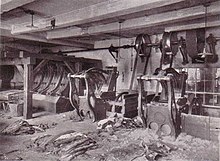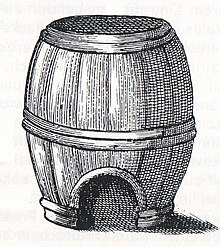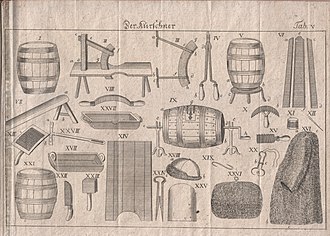Pedal stick
The stepping stick or warming stick was a device of the furriers , later of the specialized smokers , as a tool of the tobacco or fur finishing, the tanning of fur skins.
In a previous process, the raw hides had already been subjected to a similar process in almost the same trample . While the barefoot worker in the trampling barrel kicked the fat into the hide leather, the task was to remove excess fat in the same way in the pedal stick and to make the leather as soft as possible.
Structure and functionality
The pedal stick was in two parts. The lower part was a copper brazier into which hot charcoal was placed, the upper part a barrel in which the greased hides were placed on a layer of sawdust. Again with bare feet, a worker turned and trampled the skins in the barrel until the fat had fully penetrated the leather and they had become sufficiently supple. If you follow a later author, it should sometimes have taken a whole working day or longer. The worker preferred to kick the skins on one side in such a way that the mass constantly circulated and the lower skins gradually moved upwards. Since the heated brazier formed the bottom of the pedal stick, the fur hair would have been scorched if it had not been used for a long time, and the top pelts would not be adequately degreased.
If people sang during this work, it was not only due to the monotony of the occupation. The singing also served to check that the person concerned was still well in the warmth of the footsticks: "If the person stepping no longer sang or whistled, it was necessary to check whether the open coal fire under the copper tripod had not caused the worker to be dazed".
A description from the year 1762 shows that the furriers usually layered 300 with a small incense, 100 with a medium and 8 with a large one in the pedal stick. Here they were kicked for about two hours until the sawdust had absorbed all of the fat from the hair. If the skins were not completely degreased afterwards, they were put in the trampling barrel for another hour, this time together with a mixture of half sand and half plaster. Elsewhere it was said that if it turned out that the lauter powder did not adhere to the hair, fine sand or crushed plaster of paris, which had to be heated in a pan beforehand, was sprinkled with constant treading. Lower contamination may have been due to purify fixed with wood shavings, or in addition to the Tretstock in the Läutertonne .
Then the skins were carefully combed and knocked to remove the Läutermehl. Finally, they were pulled once more over the blunt iron of the furrier's bench. If the leather was still not fine and soft enough, it was finally rubbed with a pumice stone .
Technical progress

Modern technical equipment made the work in the furrier, sometimes harmful to health and, as a furrier put it, inhumane, such as that in the pedaling stick, superfluous. In 1895 the skins were predominantly fulled, but trampling was still recommended for fine skins, "the human foot is softer than the hard mallet, and the goods will rarely be damaged". Mechanical fatliquoring was done in 1925 with the hammer or crank mill, the hammers of which work the fat into the leather. In 1951, softening with an electric device called a trampling barrel was described, but apparently it did not replace trampling in the trampling barrel, but in a heated pedal stick: “This is done mechanically by trampling using the trampling barrel, which is slightly smaller than the lautering barrel . It is filled with salvator flour or a mixture of salvator flour [a white clay flour to achieve a light-colored leather] and hardwood shavings. In addition, iron and hardwood balls are placed in the bin. Due to the rotating movement of the barrel, the skins in it are thoroughly worked through. "
From the inventory of the Breslau master furrier Paul Lehnhardt
Lehnhardt, a self-employed master furrier from Breslau, who died in 1582, has received a detailed list of household items, goods and workshop inventory.
Inventory:
- 6 tanning benches, with the iron tunnels - 1 thaler
- 2 pairs of iron studs with columns - 12 gr.
- 12 irons to 1 orth
- 10 "minor" irons around 12 gr.
- 1 "new gold iron" and 2 old iron - 9 gr.
- 1 wheel and 2 stamps - 24 gr.
- 13 scratching combs and fox combs, together 18 gr.
- 5 skinning scissors and 1 old tailoring scissors - 6 gr.
- 6 stretched measures around 4 gr.
- 200 hanging rods
- 3 pairs of cartridges with boards and 6 pairs of leaves, the pair of 3 gr.
- → 1 old pedal stick, 11 hooded sticks and 2 blocks of 6 gr.
- → 1 good pedal stick, including the pedal cap - 2 talers
- → 3 good hood sticks in the good pedal stick
- 1 punching kit and 24 punching nails around 11 gr.
- 1 sweeping brush and 1 sweeping broom by 3 gr.
- 2 boards for preparing otters
- 1 workshop including the two basins and the workbench
- 6 work chairs "bad and good"
- 4 good calf chair cushions
- 10 Beizschäffer and 3 large and small tubs
- 2 dry yarn
- 3 good combing boards around 6 gr.
- 1 new sieve for pickling - 1 gr.
- 1 cart with two wheels, for skins - 9 gr.
- 1 iron "Wythe" (?)
- 1 bushel of whips "Oß" - 18 gr.
- 1 barrel with Schmer around 18 gr.
- 1 twist gallows
- 3 hammers
- 1 hour glass in the workshop
- 9 Gebund knock Plug - 3 Orth
- 2 tins with 5/4 salt
- 3 armchairs
- 4 chaff baskets and 3 market baskets.
Web links
See also
Individual evidence
- ↑ W. Künzel: From raw fur to smoking goods . Alexander Duncker Verlagbuchhandlung, Leipzig, undated (approx. 1937), pp. 6-7.
- ↑ a b c Christian Heinrich Schmidt: The furrier art . Verlag BF Voigt, Weimar 1844, pp. 91-93.
- ^ Heinrich Lange, Albert Regge: History of the dressers, furriers and cap makers in Germany . German Clothing Workers Association (Ed.), Berlin 1930, p. 75.
- ^ Johann Samuel Halle: Der Kirschner - The eighteenth treatise , approx. 1780, p. 314 and p. 315 and p. 316 . In: Workshops for Today's Arts , Berlin 1762.
- ^ Andreas Voigt: Studies on the situation of the craft in Germany , 3rd volume. Verlag Duncker & Humblot, 1895, p. 66. In: Writings of the Verein für Socialpolitik - LXIV.
- ↑ Heinrich Hanicke: Handbook for furrier . Published by Alexander Duncker , Leipzig 1895, p. 9.
- ↑ Kurt Nestler: The smoking goods refinement . Deutscher Verlag, Leipzig 1925, p. 10 .
- ↑ Alexander Tuma: Pelz-Lexikon. Fur and Rough Goods, Volume XXI . Alexander Tuma, Vienna 1951, keywords: "Rauhwaren-Aufichterei", "Trample", "Tretstock" .
- ^ Fritz Wiggert: Origin and development of the old Silesian furrier trade with special consideration of the furrier guilds in Breslau and Neumarkt . Breslauer Kürschnerinnung (Ed.), 1926, p. 171 ( → book cover and table of contents ).


